Measuring Distances on Maps: Techniques and Applications


Intro
Understanding how to measure distances on maps is crucial for numerous applications, especially in agriculture. This feat isn’t just about walking between two points; it involves using various methodologies that can make or break a farming operation. Precisely measuring distances plays an essential role in planning layouts, managing resources, and ultimately optimizing crop yields. Without a solid grasp of these techniques, farmers may find themselves facing inefficiencies that translate to lost profits.
From traditional methods to cutting-edge technologies, the landscape of distance measurement has evolved significantly. Each approach comes with its own strengths and nuances, making it vital to choose the right tool for the task at hand. Let’s embark on an exploration of the key techniques and innovations in this field, ensuring that both novice farmers and seasoned agronomists find value in this discussion.
Topic Overview
Definition and Importance
At its core, measuring distances on maps refers to the calculations made to determine the real-world space between different points shown on a map. This practice is underpinned by the understanding that accurate distance measurement directly affects agricultural planning and execution. Whether plotting out a field layout or deciding where to place irrigation systems, knowing precise distances can lead to significant advantages.
When you measure effectively, you're not just getting numbers—you're unlocking insights that can help you make better decisions regarding efficient land use, water resources, and pest management. Farmers are able to increase their productivity while minimizing waste, leading to a more sustainable practice overall.
Brief History and Evolution
The techniques used for distance measurement have come a long way since the days when farmers relied on simple pacing to estimate distances. Early methods, such as chain surveying, were rudimentary yet essential to the agriculture of past centuries. Over time, tools like the theodolite emerged, allowing for more precision in measuring angles and distances.
In modern times, with the advent of GPS technology and GIS (Geographic Information Systems), the accuracy and ease of measuring distances have reached new heights. Farmers can now access mapping software on their smartphones, allowing for immediate calculation and adjustments on the go. This evolution signifies more than just advancements in technology; it represents a wider recognition of how important measurement is in the pursuit of agricultural excellence.
Key Techniques and Innovations
Sustainable Farming Practices
Incorporating distance measurement techniques into sustainable farming involves a multitude of practices. Utilizing precision agriculture means making use of data-driven insights to tailor farming actions based on specific metrics, including distances. Strategies like crop rotation and intercropping can become more effective when farmers understand their fields in terms of spatial relationships.
For instance, when a farmer is planning out crop layouts, utilizing software tools to accurately measure distances can ensure optimal sunlight exposure and nutrient intake. Connecting these measures with variables like soil type and historical yields can result in tailored, effective strategies that boost productivity sustainably.
Advanced Agronomic Technologies
The integration of advanced technologies has transformed how distances are measured in agriculture. Drones equipped with high-resolution cameras and sensors can survey large areas quickly, gathering data that would take days to collect manually. The imagery analyzed can provide insights into not just distance measurements but also field health and potential yield.
Moreover, technologies such as remote sensing make it possible to monitor crops for growth patterns and water needs, translating this data into actionable distance-related adjustments. The GIS platforms referenced earlier play a crucial role in storing and analyzing this data, allowing farmers to make informed decisions based on sophisticated mapping of their land.
Practical Applications
Step-by-Step Guides
- Identify the Purpose of Measurement: Determine whether the need is for planning, resource allocation, or yield estimation.
- Select the Appropriate Tool: Depending on the scale, choose a method ranging from simple measuring wheels for small plots to advanced GIS software for larger areas.
- Conduct the Measurement: Utilize the chosen method to take accurate measurements.
- Analyze and Apply the Data: Review the obtained data for insights into crop placement, irrigation, or other relevant practices.
Case Studies or Real-World Examples
Consider the case of Farmer John's orchard. John used GPS-guided tractors to plan his rows with precision. Thanks to accurate distance measures, he optimized space and reduced overlapping in planting, which led to a decrease in resource usage and an increase in overall yield.
Similarly, a project conducted by the University of Minnesota showcased that utilizing GIS technology to assess field distances could elevate yield by nearly 20%, illustrating the substantial impact accurate measurements can have.
"Accurate distance measurement doesn't just save time and resources; it can be the difference between thriving and barely surviving in the competitive world of agriculture." – Agricultural Expert
Measuring distances on maps is more than a simple task; it's an integral part of successful agricultural practice. With the right techniques, farmers can harness this knowledge to enhance their productivity, make better decisions, and contribute to sustainable farming practices.
Understanding Map Basics
Maps are like windows to the world, offering a visual representation of geographical areas. They provide essential information that helps us navigate our surroundings and understand spatial relationships. In agriculture, understanding the basics of maps is crucial for effective planning and resource management. Farmers and agricultural enthusiasts rely on maps to make informed decisions about land use, irrigation practices, and crop placement. Knowing how to interpret different map types can significantly enhance productivity and stewardship of land.
Types of Maps
Topographic Maps
Topographic maps are particularly valuable because they display the terrain's contour and elevation. This feature makes them crucial for activities like field planning and irrigation management. The key characteristic of topographic maps lies in their ability to convey three-dimensional landforms on a two-dimensional surface. From hilly landscapes to flat fields, these maps provide a detailed view of the landscape which is beneficial for farmers who want to understand how elevation affects water drainage and soil health.
The unique feature of these maps is their contour lines that illustrate elevation changes, creating a visual topography. However, while topographic maps offer precise details, they can be complex to read for those not familiar with interpretation, requiring a bit of practice to identify the relevant features effectively.
Thematic Maps
Thematic maps focus on depicting specific themes related to geographical aspects, such as soil types or crop distribution. This specificity enables farmers to assess which crops would thrive in particular soil conditions, aiding in crop planning. The key characteristic of thematic maps is that they emphasize certain data variability across a region, often using color coding to represent different themes.
The unique feature of thematic maps is their capacity to simplify complex data into easily understood visuals which can help guide decision-making. Yet, they may also lead to misinterpretation if users don't fully grasp the data represented, particularly if there's a lack of accompanying context.
Navigational Maps
Navigational maps are indispensable for travel and area reconnaissance, offering routes and directions. Generally, these types of maps are designed to be user-friendly and emphasize the pathway from point A to point B. The key characteristic of navigational maps is their focus on accessibility and orientation. For farmers, understanding their local geography can inform approaches to vehicle routing and resource distribution in large agricultural settings, ultimately optimizing operational efficiency.
One notable unique feature of these maps is the use of symbols and labels for roads, waterways, and landmarks, which makes navigation straightforward. However, reliance solely on navigational maps may overlook significant topographical changes that could affect farming activities, thus they’re best used alongside other map types.
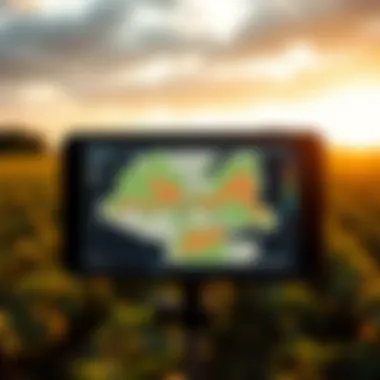
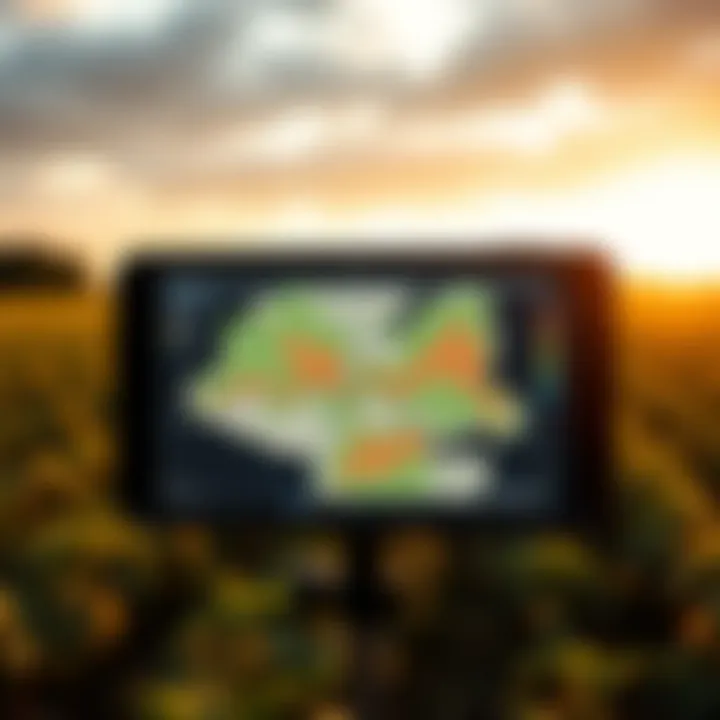
Key Features of Maps
Scales
Scales on maps provide an essential reference for understanding real-world distances as they translate the map’s representation into actual distances. This is particularly beneficial for farmers while measuring land or planning the layout of their fields. The key characteristic of scales is their ability to represent the ratio of a distance on the map to the actual distance on the ground.
One unique feature is that scales can come in various forms, such as graphical scales or numerical representations. This flexibility allows users to choose whichever is most intuitive for them. However, the downside is that if a map is scaled incorrectly, it can lead to significant errors in distance estimation.
Legends
Legends on maps serve as a guide to understanding the symbols and colors used throughout the map. This aspect is significant since it allows the user to decipher the information presented. The key characteristic of legends is that they provide clarity, ensuring that users can accurately interpret what various symbols signify.
An important unique feature is that legends often evolve with the map’s updates. However, the downside is that if the legend is not comprehensive or is poorly designed, it can cause confusion, leaving users guessing about what they are seeing.
Grid Systems
Grid systems help in pinpointing specific locations on a map, making it easier for users to navigate areas efficiently. This is especially valuable in large agricultural fields. The key characteristic of grid systems is that they divide the map into manageable sections, allowing for precise identification of locations.
The unique feature of grid systems is that they can provide a framework for complex mapping projects, but one potential disadvantage is that if someone is not familiar with the grid system, they may find it cumbersome to interpret the layout effectively.
Importance of Measuring Distances
Measuring distances accurately is the backbone of efficient agricultural practices, serving as a crucial element in myriad applications that extend beyond mere navigation. Understanding the significance of distance measurement can provide farmers and enthusiasts with tools to enhance productivity and sustainability. By measuring distances correctly, farmers can optimize their resources, manage their lands more effectively, and improve overall crop yield.
The significance of distance measurement becomes particularly evident in land management contexts and environmental impact assessments, where mistakes can lead to flawed decision-making. Consequently, the benefits stretch into areas like planning, execution, and long-term sustainability.
Applications in Agriculture
Field Planning
Field planning involves laying out crop patterns in a controlled and systematic manner. By measuring distances effectively, farmers can allocate their land more efficiently, resulting in maximized space and resources. A key characteristic of this method is precision—having an accurate layout of crops can help ensure that every plant has the right amount of sunlight, soil nutrition, and water.
Field planning is a popular choice for farmers since it minimizes waste often associated with random planting. The unique feature here is the ability to customize layouts based on the specific needs of each crop type, allowing for better intercropping strategies. However, while the initial planning can be time-intensive, the long-term advantages include improved yields and reduced resource use.
Irrigation Management
Proper irrigation management relies heavily on understanding spatial relationships and distances. By defining the distance between crops and water sources, farmers can optimize water use and save costs on irrigation. The standout feature of this method is its ability to directly influence plant growth and health.
Irrigation management is a beneficial practice because it not only conserves needed water resources but also supports sustainability efforts. The downside might be the need for continual adjustments based on changing weather conditions, which can be resource-intensive in itself. Despite this, the returns in terms of crop productivity can be substantial.
Crop Monitoring
Crop monitoring is essential for maintaining optimal growth conditions. Farmers can measure distances to determine where to place sensors or to navigate fields systematically while surveying. The critical aspect of crop monitoring is that it allows for early detection of issues, enabling timely interventions.
This technique is valued because it supports proactive rather than reactive farming practices. The unique feature is the integration of technology, such as drones or IoT devices, to gather data. While the initial setup costs may deter some, the benefits in producing healthier crops often outweigh these costs, making crop monitoring a savvy choice.
Environmental Impact Assessments
Land Use Planning
Land use planning is about strategically deciding how to allocate land resources to meet various societal needs while conserving the environment. Accurate distance measurement is vital in this aspect, as it allows planners to map out existing use and determine potential new applications for land. This practice is essential because it directly influences policies related to land conservation and agricultural efficiency.
One compelling reason for land use planning's importance is its ability to balance agricultural needs with ecological preservation, helping to avoid conflicts between different land use purposes.
However, difficulties can arise from changing conditions, such as climate change or urban expansion, which necessitate ongoing assessment and adaptation. Yet, with a keen focus on distance measurement, planners can better tackle these challenges head-on.
Biodiversity Studies
Biodiversity studies hinge on understanding the interrelations between species and their habitats, which requires precise measurements of distances between various environmental features. Measuring distances accurately is crucial for assessing habitats and determining how to protect various species. A key characteristic is the application of spatial analysis to understand patterns and make impactful conservation decisions.
This method fairs well because it enhances the ability to monitor ecological health and inform management practices. However, a downside is that biodiversity studies often require substantial data collection and analysis, which can be resource-draining. Yet, the insights gained can lead to significant conservation outcomes, making this practice worthwhile in agriculture and environmental management.
Accurate distance measurement is not just about lines on a map; it's about cultivating sustainable practices that benefit both land and crops.
Traditional Distance Measurement Techniques
Understanding traditional distance measurement techniques is essential for anyone working with maps, especially in the agricultural sector. These methods, while often overshadowed by modern technology, offer valuable insights and practical applications that remain relevant today. Traditional approaches allow for a tactile interaction with the land, enabling farmers and land managers to gauge distances accurately without the reliance on electronic devices. Furthermore, these techniques can foster a deeper connection with the environment, as they necessitate a thorough understanding of both the land’s topography and the needs of the crops or livestock.
Measuring Wheel
The measuring wheel, often referred to as a surveyor's wheel, is a straightforward yet effective tool for measuring distances on the ground. This device consists of a wheel attached to a long handle, allowing the user to roll it along a designated path while keeping track of the distance covered.
- Usage: When taking measurements in a field, the farmer walks along the intended route with the measuring wheel. Each complete rotation of the wheel corresponds to a specific distance, which is recorded on the handle's counter.
- Benefits: This method is particularly useful for measuring irregularly shaped plots, where straight-line calculations can fall short. It offers great accuracy and is easy to use, making it ideal for fields of different sizes and shapes.
- Considerations: While effective, the measuring wheel's accuracy can be influenced by factors such as terrain unevenness and the condition of the ground. For instance, rough or densely vegetated areas may yield less accurate readings. Therefore, it’s advisable to take multiple readings in such conditions to ensure a precise calculation.
Pacing Methods
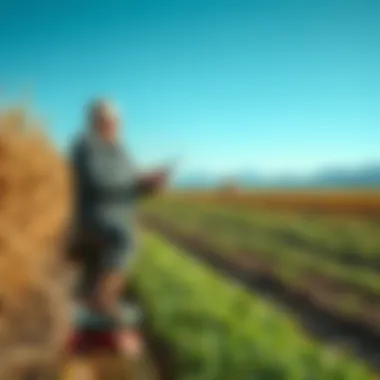
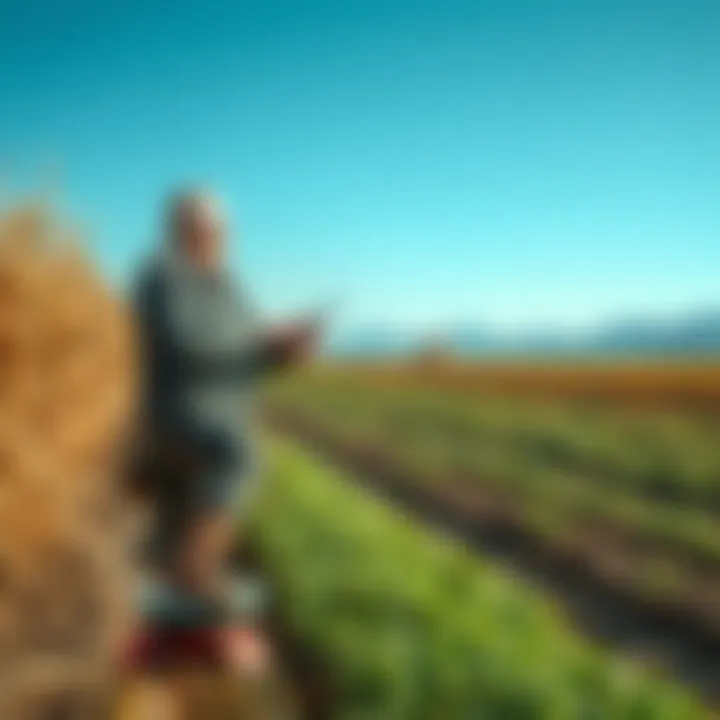
Pacing, or estimating distance by counting the number of steps taken, is one of the oldest methods known to mankind. Even in today’s technologically driven world, it holds its ground as a viable technique for distance measurement in fields.
- Basic Technique: To employ this method effectively, one must first determine their average pace—essentially the length of steps taken in a known distance. This is often established by measuring a straight home-to-field distance, for example.
- Practical Application: In practice, simply walk across the area while counting steps, then multiply the total by the average step length. While this method may not yield the precision that advanced tools provide, it remains a quick and accessible option for farmers on the go.
- Limitations: A significant downside of pacing is its inherent variability. Factors like uneven ground and fatigue can alter step length, leading to inaccuracies. Hence, it’s best employed for rough measurements where precision isn’t the priority.
Chain Measurements
Chain measurement is another traditional method that has its roots in surveying. This approach involves using a physical chain, typically made of metal, that is divided into lengths, commonly of 20.12 meters (the length of a surveyor's chain).
- Procedure: To measure a distance, the chain is stretched out along the path to be measured, and the total number of chain lengths is counted. This method benefits from its ability to deliver precise measurements over long distances.
- Advantages: Chain measurement is particularly effective in open fields or large farms where measurements may cover vast areas. Its accuracy tends to be reliable, and farmers can develop a solid understanding of their fields' dimensions using this method.
- Challenges: However, like other traditional methods, this technique demands considerable physical effort and care, particularly in rough terrain. It is also more time-consuming than simpler methods such as pacing or using a measuring wheel.
"While modern tools like GPS offer precision, traditional methods are imbued with skills and knowledge that connect the farmer to the land."
In summary, traditional distance measurement techniques have their unique strengths and weaknesses. For the agricultural community, these methods not only provide practical solutions but also embody the rich history and connection to the land that has sustained farming practices through generations. Understanding and utilizing these techniques can enhance one’s ability to manage land more effectively.
Digital Tools for Distance Measurement
In the modern world, the need for precise distance measurement on maps has grown tremendously, especially in fields like agriculture. Digital tools have transformed how farmers plan their fields, manage resources, and optimize crop yields. By utilizing these tools, agricultural enthusiasts can streamline their operations and ensure they are making informed decisions based on accurate data.
GIS Applications
Functionality Overview
Geographic Information Systems (GIS) provide a robust framework for gathering, managing, and analyzing spatial data. One of the standout characteristics of GIS is its ability to handle vast amounts of geographic information in a user-friendly format. This ease-of-use makes it a popular choice among farmers who may not be tech-savvy yet are keen to adopt modern techniques in their practice. The unique feature of GIS is its layering capability, where various data sets can be overlaid—like soil quality, moisture levels, and topography—allowing for informed decision-making. However, the complexity of GIS software can be daunting, requiring training or a learning curve that some users might find challenging.
Integration in Farming
The integration of GIS in farming presents exciting possibilities. Farmers can visualize their land's information in a geospatial format, enhancing their understanding of spatial relationships. This software enables precision agriculture, tailoring actions to specific areas rather than applying a one-size-fits-all method. A vital feature of integration in farming is the ability to synchronize GIS data with other technologies, like drones or soil sensors, creating an interconnected ecosystem of agricultural monitoring. Still, reliance on technology introduces an element of risk, as system failures or data inaccuracies can compromise decisions.
Online Mapping Services
Google Maps
Google Maps has revolutionized how individuals and businesses navigate and measure distances. Its widespread use in many applications makes it an accessible tool for farmers looking to measure distances quickly. One key characteristic is its user-friendly interface combined with real-time traffic updates. Farmers can check routes to their fields or suppliers while considering the current traffic situation, ensuring timely deliveries and trips. However, one downside is that the accuracy of Google Maps can vary in rural areas where maps may not always reflect the latest developments.
OpenStreetMap
OpenStreetMap (OSM) operates on a crowd-sourced model, meaning its data is continuously updated by users worldwide. This aspect of OSM is particularly beneficial, as it allows for increased local knowledge to be integrated into the mapping data, especially in agricultural regions that may not be well covered by commercial services. A unique feature of OSM is its customizable layers; farmers can adapt maps for their specific needs, like highlighting irrigation zones or soil types. The downside, however, is that since it's community-driven, the accuracy of the data may vary depending on user contributions, necessitating caution and cross-verification.
Mobile Applications
Field Data Collection
Mobile applications designed for field data collection bring distance measurement right to the farmer’s pocket. These apps often come equipped with GPS functionality that allows for pinpoint accuracy in gathering data about fields. This immediacy means farmers can get real-time measurements without needing to return to the office or rely on cumbersome equipment. A significant advantage is the ability to collect and analyze data in the field, making it easily accessible and actionable for immediate decision-making. However, heavy reliance on mobile networks can be problematic in rural areas where connectivity is spotty, limiting the app’s effectiveness.
GPS Tracking Tools
GPS tracking tools are game changers for farmers, allowing for precise location tracking over large areas. They help in monitoring equipment or livestock, ensuring nothing gets lost. This technology can greatly assist in distance measurement, providing exact boundaries for fields or properties. A notable feature is the capability to create geo-fenced zones, alerting farmers if equipment or animals stray beyond designated locations. Conversely, while these tools greatly enhance operational awareness, they can also be costly, requiring investment in devices and subscriptions, which might not always fit into every farmer’s budget.
"Digital tools redefine how we approach distance measurement and mapping, ensuring accuracy and efficiency in our practices."
Measuring Distances: Step-by-Step Processes
In the realm of map reading and distance calculation, the various methods employed play a crucial role. Understanding how to effectively measure distances using different techniques not only enhances accuracy but also makes navigating and planning a much smoother process. Each method, from the rudimentary to the digitized, provides distinct benefits that can cater to specific needs. In agriculture, where precision is paramount for resource management and crop placement, the ability to measure distances accurately becomes a game-changer.
Using clear protocols, we can ensure that the measurements we take are both reliable and effective, setting the stage for better decision-making in diverse agricultural settings.
Using a Scale
Scaling Down the Measurement
Scaling down the measurement involves converting real-world distances to a smaller, manageable scale that can be interpreted from a map. This process is central to understanding any geographic representation and plays a significant role in the field of agriculture. By utilizing a scale, farmers can gauge distances between rows, calculate land plots, and assess spacing for crops without needing to traverse the entire landscape.
One key characteristic of this technique is its simplicity. Many farmers might find it less daunting than digital methods because it relies on visual measurements rather than technical expertise. However, while it is straightforward, it also has its drawbacks. Misreading the scale can lead to significant errors, which can affect planting density or resource allocation. Nonetheless, when done correctly, scaling down ensures that the measurements are easily relatable to real-life scenarios, making it a popular choice in both education and practice.
Calculating Real Distances
Calculating real distances dives deeper into converting scaled measurements back to their actual lengths. This step is invaluable in ensuring that all the preliminary calculations lead to actionable information. Using the map scale, farmers can convert the simplified measurements into actual distances, providing clarity and facilitating accurate planning for irrigation systems, crop layouts, and other agricultural functionalities.
A notable aspect of this technique is its connection to precision; by calculating real distances accurately, the risk of mistakes decreases. Moreover, while considering its importance in agricultural planning, the accuracy of this method can sometimes hinge on the legibility and accuracy of the map itself. In situations where high-quality maps are used, farmers have a reliable foundation for their calculations, ultimately impacting yield outcomes positively.
Mapping Software Techniques
Inputting Data

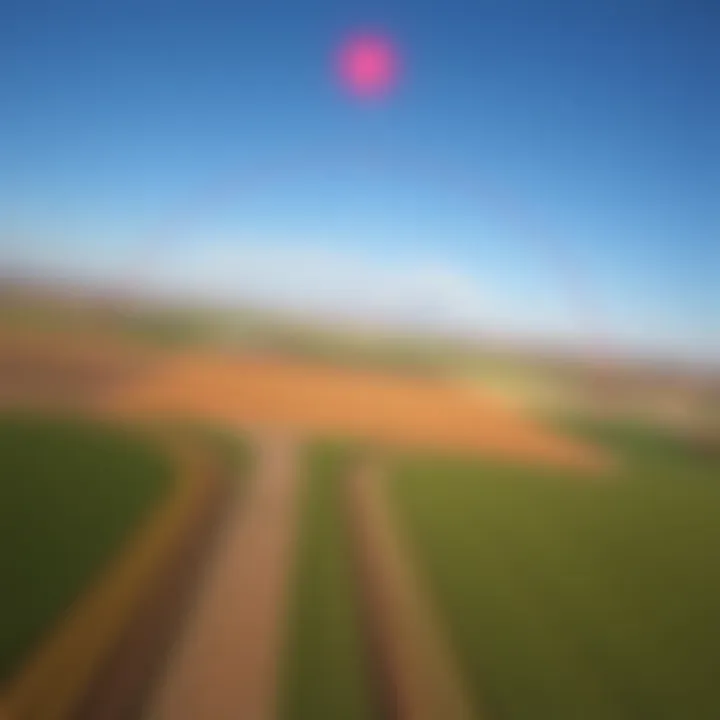
The digital age brings forth mapping software techniques that can revolutionize distance measurement for agricultural applications. Inputting data effectively into these platforms allows users to manage and visualize vast amounts of spatial data with ease. Such software not only showcases distances but also incorporates layers of vital information like soil types and crop viability.
What makes this method beneficial is precisely its ability to aggregate and analyze large datasets together. Once the data is entered, users can explore various scenarios through simulation, which can greatly enhance their decision-making processes in real-world farming conditions. However, entering inaccurate data or failing to keep it updated can skew the process entirely, leading to misguided strategies. Nevertheless, when executed properly, inputting data serves as a vital tool to elevate agricultural practices.
Interpreting Results
The final step in leveraging mapping software involves interpreting the results derived from inputted data. This part of the process is often where the rubber meets the road – it's about taking raw distance measurements and transforming them into actionable insights. For agribusiness, interpreting results could provide guidance on optimal planting strategies or indicate areas needing improvement in yield productivity.
A primary characteristic of interpreting results lies in the potential for customization; results can be dissected to explore various farming scenarios or management techniques according to specific needs. Moreover, it's also an area where farmers can run the risk of over-complication; mishandling data analysis can lead to confusion, rather than clarity. Ultimately, proper interpretation is fundamental to translating distance measurements into enhanced agricultural effectiveness.
"In agriculture, the right measurement can make all the difference. Accurate distances lead to better planning, which translates to agricultural success."
By mastering these processes—from scaling down measurements to effectively using software—all participants in the agricultural field can foster a deeper understanding that paves the way for successful outcomes. Effective distance measurement techniques hence become integral to informed decision-making and resource management.
Challenges in Distance Measurement
Measuring distances on maps is more than just a technical process; it’s a skill that carries important implications across multiple fields, particularly agriculture. Despite the availability of tools and methods, various challenges persist that hinder the precision and effectiveness of distance measurement. Factors like accuracy limitations and data interpretation issues can complicate the task, often requiring farmers and agricultural professionals to refine their methodologies and adapt to overcome these hurdles.
Accuracy Limitations
Human Error
Human error stands as one of the most significant contributors to accuracy limitations in distance measurement. In the agricultural sector, where precision is a must for successful yield and resource management, even a small error can have cascading effects. For instance, when utilizing hand-drawn maps or manual calculations, inaccuracies can easily creep in due to misreading a scale or misplacing a point on a map.
The key characteristic of human error is its unpredictability. It's not just a matter of poor judgment; fatigue, distractions, or simply rushing through measurements can lead to mistakes. This makes understanding and mitigating human error crucial for this article, as it emphasizes the need for clear protocols and systematic approaches in measuring distances accurately.
One unique aspect of human error is that it’s often preventable with careful planning. Training and practice can vastly improve one’s ability to take accurate measurements. Moreover, integrating technology—using GPS devices or mapping software—can minimize reliance on manual methods, thus reducing the likelihood of inaccuracies. The challenge here remains not just about recognizing human error but creating strategies to mitigate it effectively.
Environmental Factors
Environmental factors also play a critical role in affecting distance measurements. These factors include, but are not limited to, variations in terrain, weather conditions, and even the scale of measurement itself. For example, when measuring a field that has uneven ground or dense vegetation, the distance calculated can significantly differ from the actual distance if one does not account for such variables.
What makes environmental factors particularly challenging is their variability; conditions can change rapidly, affecting measurement outcomes. For instance, rain can make certain landscapes difficult to traverse, leading to inaccurate data gathering. This highlights the importance of understanding and planning for environmental conditions as a beneficial aspect of this journey.
A unique feature of how environmental factors impact distance measurement is the need for adaptability. Farmers and agricultural professionals are often in dynamic settings, and recognizing the influence of the environment requires a flexible approach. It’s essential to keep in mind that factors such as soil saturation or seasonal changes can shift the ground, necessitating re-measurement and careful consideration.
Data Interpretation Issues
The complexity doesn't end with measurement; data interpretation presents its own set of challenges. After taking measurements, interpreting that data accurately is crucial for making informed decisions in agriculture. Misinterpretation can stem from overlooking important variables, such as scale or context, and can lead to poor planning or resource allocation.
This challenge underscores the necessity for a robust understanding of both the tools used for measurement and the context in which the measurements are applied. Farmers need to be adept not only at collecting data but also at deciphering what that data signifies within the framework of their operational goals.
"Accurate distance measurement is not merely a number; it's about making informed decisions that can influence crop yields and resource management."
In summary, while measuring distances on maps offers tremendous benefits in agriculture, various challenges pose risks to success. Understanding the limitations of accuracy, dealing with environmental factors, and mastering data interpretation are pressing concerns that need attention. Embracing these challenges can lead to improved practices and a deeper understanding of how distance measurement contributes to better agricultural outcomes.
Future Trends in Distance Measurement
The realm of measuring distances on maps is continuously evolving, integrating new technologies and methodologies that significantly enhance accuracy and efficiency. As we navigate through this changing landscape, it’s important to understand these trends and how they can be applied across various fields, particularly in agriculture. The future of distance measurement not only promises improved precision but also opens doors to greater data utilization and strategic planning for farmers and agricultural specialists.
Advancements in Technology
Satellite Imaging
Satellite imaging is a game-changer in distance measurement. This technology uses satellites orbiting the Earth to capture images and data that can be translated into accurate geographical information. One of the key characteristics of satellite imaging is its ability to cover vast areas in a relatively short time, making it an invaluable tool for monitoring agricultural practices.
A unique feature of satellite imaging is its capability to provide data that is not just visually informative but also rich in analytical potential. It allows farmers to receive detailed insights about land use and crop health. However, one disadvantage to keep in mind is the potential for cost, as advanced satellite services may require substantial investments. Nevertheless, for those aiming for precision and efficiency in measuring distances and managing resources, the advantages outweigh the drawbacks.
AI Integration
AI integration in distance measurement is another remarkable advancement. By employing artificial intelligence, tools can analyze data collected from different sources, including satellite imagery and sensors, to extract meaningful insights. AI's key characteristic lies in its ability to process large sets of data quickly, identifying patterns and anomalies that might elude human analysis.
What sets AI apart is its adaptability; it learns from past data and improves over time, enhancing its predictive capabilities. The disadvantage, however, could be the reliance on high-quality data—input data that is inaccurate or incomplete could lead to misguided results. Despite this challenge, AI remains a popular choice for those looking to revolutionize agricultural practices by improving distance measurement and resource management.
Impact on Agriculture
Precision Farming
Precision farming is an innovative approach that leverages advanced technology to optimize agricultural practices. This concept revolves around the idea of tailoring farming methods to the specific needs of crops and land. The key characteristic of precision farming is its focus on data-driven practices, ensuring that every decision is backed by thorough analysis rather than guesswork.
One unique feature of precision farming is its use of various sensors and GPS systems to monitor everything from soil health to crop yields. This technology allows farmers to apply resources like water, fertilizers, and pesticides in a targeted manner, minimizing waste while maximizing productivity. However, farmers must consider the initial costs and required training to get started with these technologies, which can be a barrier to entry for some. Yet, those who embrace it often find the long-term benefits to be worth it.
Data-Driven Decision Making
Data-driven decision making is increasingly vital in agriculture, as farmers strive to make informed choices that affect yield and efficiency. By analyzing comprehensive datasets sourced from various technologies, farmers can anticipate challenges and respond proactively. The core of data-driven decision-making is its emphasis on empirical evidence—farmers are no longer relying on tradition alone but are utilizing hard data to steer their practices.
One outstanding aspect of this approach is that it allows for real-time adjustments in the field. For example, if satellite data indicates a potential issue in one part of a field, farmers can redirect resources accordingly to mitigate loss. On the flip side, navigating vast amounts of data can be overwhelming, and not every farmer has access to the sophisticated tools required for thorough analysis. Nonetheless, the clear advantages of informed decision-making are propelling this technique into the forefront of modern agriculture.
"As technology continues to evolve, the application of distance measurement tools is becoming more precise and efficient, paving the way for farmers to enhance their productivity and sustainability."
In summary, the future trends in distance measurement hold a wealth of opportunities for agricultural practices. By embracing advancements like satellite imaging and AI, alongside methodologies such as precision farming and data-driven decision making, farmers stand to gain significant benefits that will enhance both yield and resource management.



